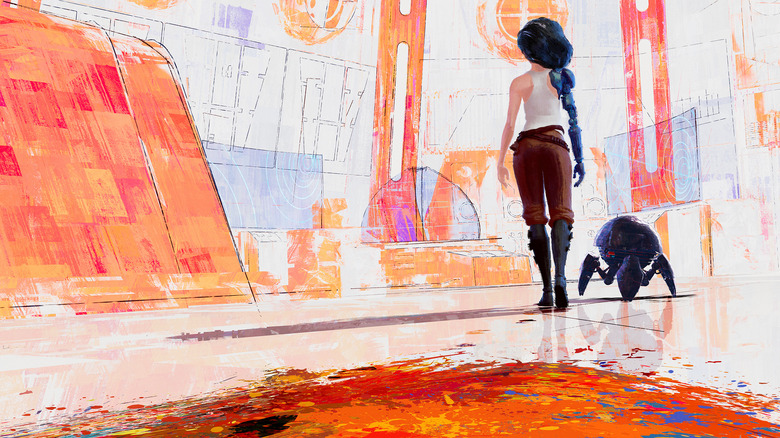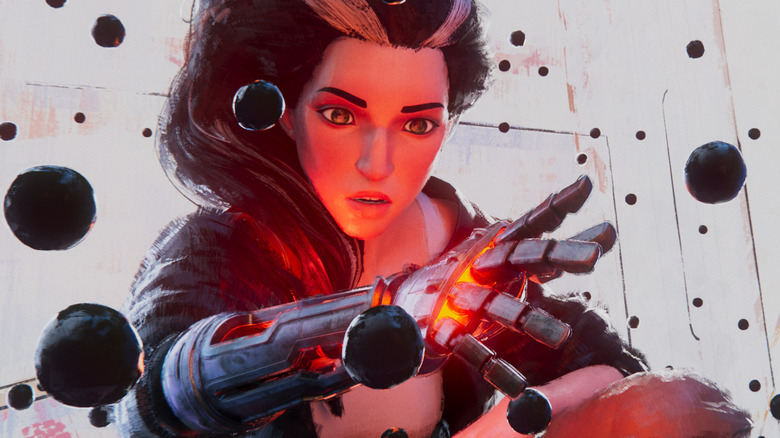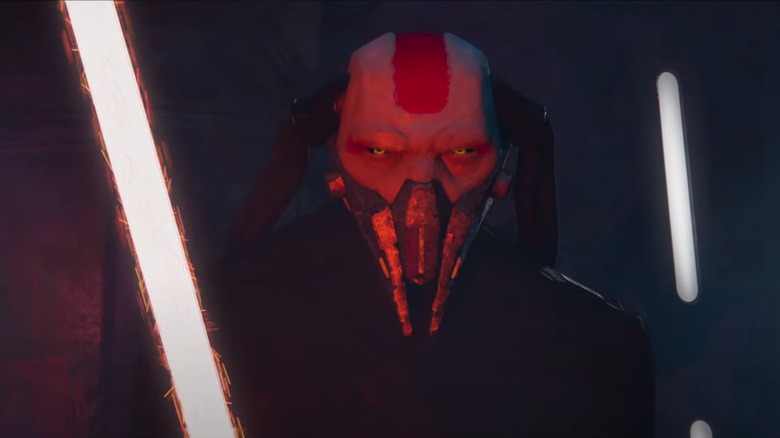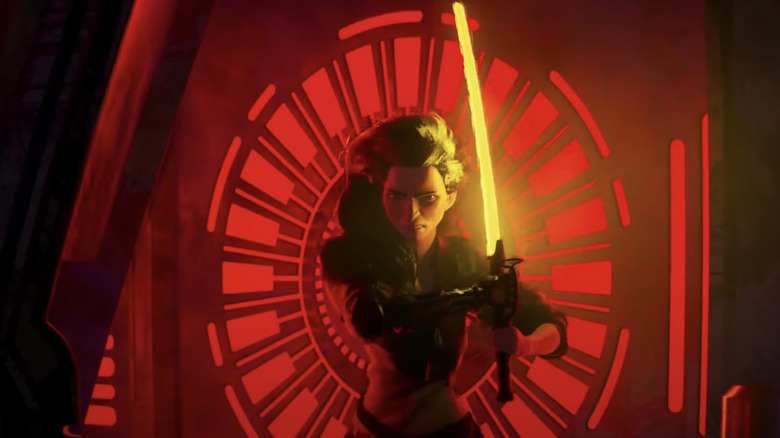Star Wars: Visions Season 2 Pulls Off What The Movies Never Could
This article contains spoilers for the first episode of "Star Wars: Visions" season 2.
For those who regard "Star Wars: Visions" as one of the most exciting additions to the entire franchise, it's no surprise that the very first installment of season 2 feels unique and distinct right from the first minute. Rather than starting with an opening crawl or a slow pan across stars, as the main saga movies do, we open on an almost impressionistic landscape completely devoid of color and form. Produced by Spanish animation studio El Guiri and directed by Rodrigo Blaas, the episode (which is plainly yet evocatively titled "Sith") proves to be a fascinating choice to kick off this next batch of shorts — not only for its aesthetic risks, as impressive as they are, but for boldly and unapologetically evolving some of the most core tenets of the "Star Wars" universe, too.
As we soon learn, the very premise of "Sith" throws a curveball at fans. The short follows a mysterious renegade by the name of Lola (voiced by Úrsula Corberó), who appears to have left her Dark Side ways behind her and is content to live a life of peaceful exile, expressing her talent as a painter through the Force. As Blaas has explained before, his use of color isn't meant as a mere gimmick, but to reveal the kind of emotional layers that a 14-minute short doesn't have the time to do otherwise. But when her old Sith master shows up one day in retribution of abandoning him and his cohorts after her apparent change of heart, their confrontation ends up challenging our preconceived notions of both the Light and the Dark Side.
In short, "Sith" brings balance to the Force in a way that the movies simply never could.
Light and dark
What's remained most refreshing about "Star Wars: Visions" has been each episode's willingness to push the boundaries of what this franchise is all about. Unlike the most recent sequel trilogy, which either hewed suffocatingly close to the look and feel of the 1977 movie (looking at you, "The Force Awakens") or bent canon to the breaking point in order to shoehorn old franchise staples into the proceedings (somehow, discourse on "The Rise of Skywalker" returned), "Visions" has taken a completely different route altogether. Who knew that filtering the tropes and trappings of "Star Wars" through whole new perspectives and letting talented creatives wild out on their own terms would result in a slew of engaging, original, and thoroughly entertaining stories set in that galaxy far, far away?
While that result may not be so shocking, however, what "Sith" manages to accomplish is nothing short of a creative coup.
The episode takes pains to set up the inner conflict at Lola's core. If her sinister robo-arm or noticeably Imperial-designed droid friend wasn't enough to indicate how her former allegiances integrate seamlessly with her new path, the black that keeps encroaching upon her impressionistic, Picasso-like artwork strongly hints at her own darkness within her ... a darkness that, despite the warm and inviting tone early on, warns her past isn't done with her just yet. The symbolism even extends to when she ventures out into the wilderness to fix a broken beacon signal, silhouetted by giant planets eclipsing a nearby star — in other words, light and dark, coexisting in perfect cosmic symbiosis.
When she's forced to battle her former allies in a life-or-death struggle, "Sith" pays off beautifully on all its prior setup and, in the process, suggests a third alternative to the Dark Side and the Light.
New balance
In "Star Wars" lore, the grand Jedi prophecy surrounding Anakin Skywalker foretells a Messianic-like figure who will bring balance to the Force by destroying the Sith, once and for all. Taken at face value in the prequel and original trilogies, the fall and eventual redemption of Darth Vader would seem to fit the bill. Despite hastening the destruction of the Jedi Order and plunging the galaxy into fascist control, his (apparent) killing of Palpatine and the dissolution of the Empire sure seems to fulfill the prophecy ... even though the eradication of the Sith and the prosperity of the Jedi doesn't seem very "balanced" to a neutral observer. From an in-universe point of view, the mere existence of the sequel trilogy further muddies the waters — such balance seems to be anything but, given the rise of the First Order and (sigh) Palpatine's ultimate return.
Yet even by the end of the Skywalker Saga, was balance in the Force ever truly achieved?
By focusing on just one small story in the middle of nowhere and interrogating this topic on a micro-scale, "Sith" ignores all these contradictions in the grand scheme of things and, as a result, reaches a much more potent conclusion than the movies ever did. In her final duel with the Sith lord, Lola unveils her new yellow-tinged lightsaber and decisively announces that she's "found my own path." Faced with her former master's claims that "Darkness is your fate," Lola comes to the realization that light and darkness are part of her painting and, by extension, an inextricable part of herself. Igniting her double-bladed lightsaber (one side yellow, the other red), the apprentice deals a deadly blow to her master.
Traditionally considered an inescapable path to the Dark Side, killing becomes Lola's hero moment instead.
The best of both worlds
Fans may be tempted to call foul, protesting that this short doesn't play by franchise "rules" and upends decades of George Lucas' "Star Wars" ideals. But consider the utterly ambiguous note that "Sith" leaves viewers on and how thrilling it is to wade out into uncharted waters in a 45-year-old franchise that, admittedly, had begun to feel a little stale.
"Sith" chooses to find balance in the Force by contrasting two very different worldviews. Lola begins the short having appeared to have found a way out of her former life. It's not important to know exactly how, but that she's done so and that it isn't fully working out. We meet her in the middle of an unexplained nightmare, after all, surrounded by stark black marks emanating from her body. But clearly, life as a Sith didn't sit well with her, either. If she can't find balance as a Jedi-like hermit or as a dangerous Sith, the unspoken question at the heart of the story pointedly asks us: What else is out there for her?
The answer, as it turns out, is a combination of both. "Sith" aligns with the franchise's time-honored notion that atonement is never out of reach. It just might require a slightly different method than Anakin, Ben Solo, or anyone else ever dared to walk themselves. By embracing her inherent darkness but upholding the undeniable Light expressed through her painting, Lola unlocks a third option for herself.
We'll likely never know whether this works out for her in the end, but by dangling that question and asking fans to wrestle with the complicated nuances of the property they love so much, "Visions" once again does what the movies could not.
Season 2 of "Star Wars: Visions" is currently streaming on Disney+.



